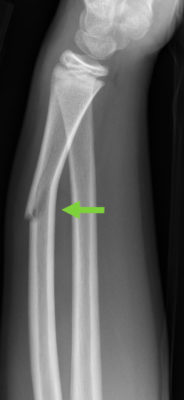
Summer in Cincinnati is a time to get outside and play! Here in the Radiology Department at Cincinnati Children’s, the nice weather also means that we are seeing more kids who need x-rays for broken bones.

Did you know that kids’ bones look a lot different on x-rays than adult bones? While children are still growing, there are areas on the ends of the bones called physes or “growth plates.” These growth plates appear on x-rays as dark lines through the bone – but so do fractures. As part of our training, pediatric radiologists gain extra experience and skill at recognizing the difference between these growth plates and actual fractures. To make things even trickier, many kids will have what we call “developmental variants” or “accessory ossification centers.” These can be easily mistaken for fractures, and there are so many of these variants that entire textbooks have been dedicated to them! Fortunately, pediatric radiologists are specially trained to recognize these as well.

Kids also have softer and more flexible bones than adults, which means they sometimes get specific types of fractures that adults don’t get. One of these fractures is called a buckle fracture, which occurs when one side of the bone gets crumpled, often in the forearm after a fall on an outstretched hand. These fractures can sometimes be very difficult to recognize and may only show up as a tiny bump on the side of the bone. Another type of fracture seen particularly in kids is a greenstick fracture. These fractures occur when the bone becomes bowed and one side of the bone breaks, but not the other – just like when you try to break a stick that is too green.

We hope that you and your family have a safe and injury-free summer. But if your child needs an x-ray for a possible broken bone, don’t forget that the pediatric radiologists at Cincinnati Children’s have special training and experience in recognizing some of the tricky fractures – and potential pitfalls – in kids’ bones! We’re here 24/7, so we will always be here if you need us!
Contributed by Dr. Emily Orscheln and edited by Janet Adams, (ADV TECH-ULT).
